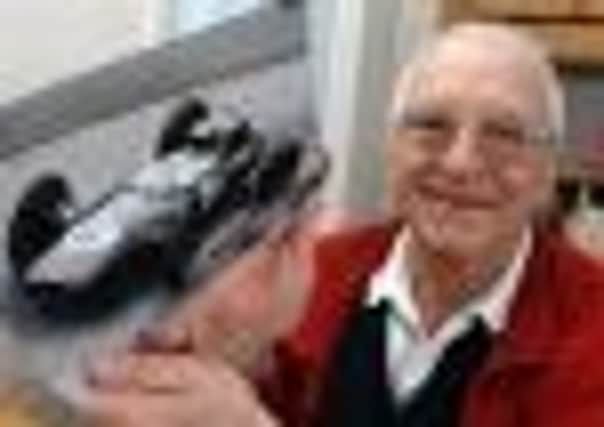‘I shot out of the cockpit in one direction, the car spun through the air in flames in the other’


Jenson Button, the 2009 world champion, was a pleasure to speak to. Knowledgable, affable, confident in his opinions on either his own McLaren or the misfortunes of Marussia Virgin Racing, Button was the type of interviewee one could have sat in the company of for hours.
Timo Glock was the South Yorkshire-based team’s German driver.
Advertisement
Hide AdAdvertisement
Hide AdCold, mechanical and efficient – he came across as not knowing his Dinnington from his Dusseldorf.
The empathy that came in bucket loads for the hardships John Booth was enduring as team principal, was in much shorter supply for Glock.
The third driver, Trevor Taylor, was someone I only had the fortune to interview once; his colourful, eventful life coming to an end in September, 2010, after a long battle against cancer.
Taylor was 73 and still in close contact with Booth as his fellow son of Rotherham lived the life and walked the walk he once enjoyed.
Advertisement
Hide AdAdvertisement
Hide AdTaylor lived his own life to the full, his maxim in an era when around five drivers a year were killed being: ‘If I’m going to go, I’m going to go happy’.
If hours could have been spent in the company of Button, it was days with Taylor, who spun yarns of dangerous pranks, the playboy lifestyle and of death-defying escapes.
The 2012 Formula 1 season, which begins this coming weekend on the opposite side of the world in Melbourne, marks the 50th anniversary of Taylor’s most productive year in motor-sport’s highest grade. One podium finish in the 1962 season does not mark his achievement out to be one remembered in the annals of the sport’s rich history alongside the landmark of Juan Manuel Fangio’s fifth title, the death of Ayrton Senna or the first commentary of a young, shrieking Murray Walker.
But for Taylor – who raced 29 times in Formula 1 – it was a record to be proud of.
Advertisement
Hide AdAdvertisement
Hide AdHe raced nine times in the Formula 1 championship of 50 years ago, finishing four races and retiring five times.
He drove for Lotus, alongside an up-and-coming young driver named Jim Clark, who would go on to win two world titles before suffering the fate of many of their kindred spirits of the era – death behind the wheel.
Taylor’s one and only podium came in his first race of the year at Zandvoort in the Netherlands.
Zandvoort was the scene of one of Formula 1’s most tragic events in 1973 when Roger Williamson’s car flipped over and burst into flames, trapping the Englishman in the inferno.
Advertisement
Hide AdAdvertisement
Hide AdThe images of a helpless David Purley trying to rescue his colleague from the uncontrollable inferno painted a horrifying portrait of what for too long was a needlessly reckless era.
Taylor endured his own brushes with death in a career in motor-sport that spanned 15 years.
“In Mount Etna one year, I was behind John Surtess and Lorenzo Bandini,” recalled Taylor. “Bandini hit the armco barrier in front of me and all this gravel and muck hit me in the face, knocking me out. My car hit Bandini’s, I shot out of the cockpit in one direction, the car spun through the air in flames in the other.
“I woke up in the ambulance. All I had was a back full of friction burns.
Advertisement
Hide AdAdvertisement
Hide Ad“If I’d have been wearing a seatbelt I wouldn’t be here today.
“We used to lose five drivers a year. Today, they can run into a brick wall and walk away.”
Not that Taylor decried such advancements in technology, or health and safety regulations.
The deaths of Dan Wheldon and Marco Simoncelli last year, are, thankfully, relatively isolated incidents nowadays.
Advertisement
Hide AdAdvertisement
Hide AdFormula 1 has not lost a driver since the San Marino Grand Prix of 1994 when Senna and Roland Ratzenberger were killed in separate accidents.
The cars that Button and Glock will drive around Melbourne and the 19 other circuits during the Formula 1 season are aerodynamic bullets built like articulated lorries.
Fifty years ago, Taylor and the men he drove against risked their lives every time they sat in the cockpit.
“That’s why I used to enjoy myself,” he said. “It was a brilliant life and I was a real jack-the-lad.”
Advertisement
Hide AdAdvertisement
Hide AdBooth may have been forced to relocate his team to the motor-sport heartland of the south Midlands but their legacy remains at Dinnington.
And Taylor’s own legacy endures. The yellow overalls and helmet he raced in prompted the yellow stripe down the green Lotus cars of the 1960s that can still be seen today on the Lotus marque that returned to F1 in 2010, and which in 2012 will carry the name of Caterham.